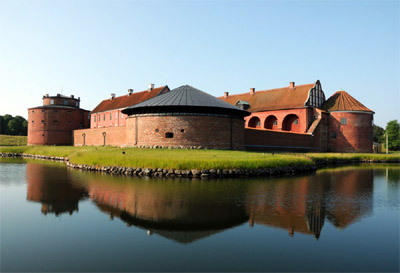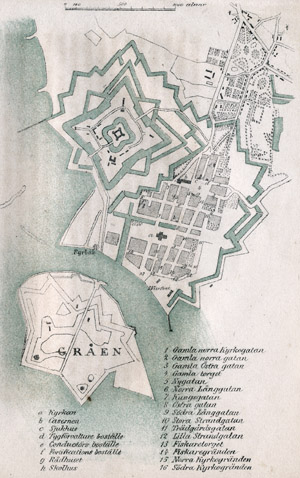 |
Landskrona Citadel
Landskrona, Sweden
|
|
 |
Castle constructed: 1549-1559
Starfort elements constructed:
1666 - 1675
Built by: Danish King Christian III
Used by: Denmark, Sweden
Conflicts in which it participated:
Scanian War,
various other Danish/Swedish squabbles
|
The city of Landskrona was established in 1413, at one of those natural harbors that seem to spontaneously grow starforts the world over. It's in Sweden's southernmost province of Scania, which back in the 15th century was part of the Kingdom of Denmark.
Well placed for commercial traffic with Copenhagen, Landskrona did pretty well for itself, which upset the Hanseatic League: This was a commercial and defensive confederation of merchant guilds and their market towns in northern Europe from the
|
 |
|
|
13th through 17th centuries, which among other things fielded its own army. This Hanseatic army attacked and destroyed Landskrona in 1428. Talk about a protection racket!
Danish King Christian III (1503-1559) had a castle built to protect the important harbor at Landskrona, a project that lasted from 1549 to 1559. We starfort enthusiasts know that a castle is a pretty silly form of fortification as compared to a starfort, but this was the dawn of the starfort age, so perhaps Christian III may be excused for this poor decision. The castle was pretty impressive by most accounts, with a huge, 70-meter-wide moat around it.
In 1591 Landskrona Citadel was visited by Tycho Brahe (1546-1601), a vastly rich Danish nobleman who was known as an astronomer and alchemist. Tycho brought his tame pet elk (?!), which drank a large quantity of mead (a disgusting-sounding alcoholic beverage) left on the castle's banquet table, subsequently falling down a flight of stairs and breaking one of its spindly legs. Despite receiving a great deal of tender care, the elk did not survive, tragically ending its life with broken bones and a hangover.
|
|
 |
In early April of 1644, Swedish forces led by Gustav Horn (1592-1657) entered Landskrona with the intent of capturing the Citadel from its Danish garrison of 300 mostly inexperienced newbs, a feat that was achieved on April 7 after a fierce bombardment. 1000 Swedish troops took up residence in Landskrona Citadel, but it was returned to Danish control the following year as part of peace negotiations.
The Treaty of Roskilde (1658) took place during the Second Northern War (1665 - 1660) and gave Scania and |
|
several other Danish provinces to Sweden. Landskrona was now 100% Swedish, and in 1666 Sweden's King Charles XI (1655-1697) started upgrading Landskrona Citadel to full starfort status. Or whomever was making decisions for Charles XI got the starfort ball rolling, as Charles was all of eleven years old at the time.
Once the new work on Landskrona Citadel was completed in 1675, it was widely considered the most modern and unassailable fortification in Europe...just in time for the Scanian War (1675-1679) to prove otherwise. Intent on recapturing those provinces lost to Sweden in 1658, Danish King Christian V (1646-1699) launched an invasion of Scania that brought hostile troops to Landskrona Citadel's front door in July of 1676.
|
Though the Citadel was well garisoned with 1,600 "well trained troops," the Danes brought nearly 8,000 men. The attackers drained the outer moat for ease of access, and let loose as fierce a barrage as their 29 cannon could provide. Landskrona Citadel's commandant, Colonel Hieronymus Lindeberg, held out for eight days until his wife Ingrid ordered him to surrender, because she couldn't stand the noise of the bombardment for a moment longer. Landskrona Citadel was once again the property of Denmark, and Hieronymus Lindeberg was tried for treason (he had been expected hot hold out to the last man), found guilty and executed in December of 1677. One hopes that his wife was at least stabbed a little as well.
There is another version of this story, in which Ingrid was heavily pregnant with twins at the time of the siege. Women going into childbirth under extreme circumstances was as inadvisable then as it is now, and Hieronymus surrendered the Citadel to save his wife and children. Ingrid did receive a pension from the Swedish crown that had executed her husband for treason, so one imagines that at least the King thought she was relatively blameless.
Landskrona Citadel was used as a base of operations for Danish Friskyttar, a unit of guerilla fighters that caused Sweden no end of trouble in Scania through the rest of the war.
|
 |
Landskrona Citadel as it lies today, with the pointy yet pointless-looking outerworks of Gråen to the south |
|
The Scanian War ended in 1679, and Landskrona Citadel, once again, returned to Swedish control. By 1700 Sweden was back on its feet with a world-class army and navy, arms that were reaching out and pounding on neighboring kingdoms, forever extending what was by now an increasingly impressive Swedish Empire. Such a threat to regional stability was Sweden that Russia, Denmark-Norway, Saxony-Poland-Lithuania and a few other weirdly hyphenated kingdoms joined to check Sweden's King Charles XII (1682-1718), in what would be called the Great Northern War (1700-1721). Landskrona Citadel wasn't involved in any fighting during the Great Northern War, but did participate by housing Russian and Polish prisoners: 60 were reported to have been "guests" (prisoners) at the Citadel in 1707.
|
 The citadel part of Landskrona Citadel The citadel part of Landskrona Citadel |
 |
By the end of the war, King Charles XII was dead, most of the alliance against Sweden had fallen away in petty squabbles, and Russia was the greatest power in Eastern Europe. Sweden still had plenty to defend, however, and the Citadel was by now considered insufficient to the task of protecting Landskrona's harbor.
Work on a new fortification just to the south of the Citadel began in 1754. Utilizing a small island at the mouth of Landskrona's harbor known as Gråen, the new fortification was named Adolph's Stronghold, after Swedish King Adolph Frederick (1710-1771). |
|
Adolph's Stronghold became the focus of a great deal of study, consternation and nail-biting in the 30+ years of its construction: At one point a commission that had been organized to study the fortification's building process estimated that at the current rate of progress, the Stronghold would not only be completed in the year 2110, but would cost a grand total of 300 barrels of gold, as opposed to its initial estimated cost of five barrels. Adding to the problems Adolph's Stronghold was already experiencing, the military threat was now coming from the exact opposite direction: When the Stronghold was begun, Denmark had been considered the scariest adversary, whereas Russia had since evolved as a much more pressing foe.
|
The fortifications on Gråen were officially abandoned in 1788, having never been completed. The expansion of all fortifications in the city of Landskrona was halted in 1805, and it was declared an open city in 1822, meaning that it would not contest the matter if anyone should want to attack it. Which seems an odd decision, as there was no active conflict going on, but whatever.
In 1827 it was determined that Landskrona Citadel would henceforth operate primarily as a prison for those serving life sentences, and in 1870 the Citadel ceased being an active military fortification, so as to better concentrate on its role of executing prisoners.
In 1902 the Starfort of Our Current Interest became a women's prison, which wound up mostly imprisoning prostitutes, or "joy girls." By 1918 it was estimated that the vast majority of Sweden's prostitutes had spent time at Landskrona Citadel, which doesn't seem to have done a very effective job of convincing the girls to go into another line of work, as they seemed to keep coming back again & again.
The aging prostitutes were booted out in 1940, and the military moved back in, so as to better be neutral in the Second World War (1939-1945). Sweden's neutrality was somewhat questionable, as they supplied Germany with some machined parts and steel for their war effort, but also supported the Norwegian resistance movement and saved
|
 |

A plan of Landskrona and Adolph's Stronghold: Click for the full-sized image, which is truly awesome. Thanks, Wikipedia! |
|
a number of Danish jews from deportation to concentration camps. Regardless, the Nazis didn't occupy Sweden during the war, so didn't make it to Landskrona Citadel. After the war a refugee camp was established at the Citadel. That seems a small price to pay, your home being destroyed and life uprooted, just for the chance to live in a starfort for a few years? Some 22,000 displaced folks stayed at Landskrona Citadel between 1945 and 1953, when the last of them finally moved on.
Since the early 1990's there has been an annual Medieval market held at the Citadel. Today, Landskrona Citadel has some elements of a museum, and operates daily guided tours ("not expensive") during the summer.
Ten thousand thanks to starfort enthusiast Anders Gabrielsson, who thoughtfully alerted me to this awesome starfort!!
|
|
|
|
|
|
 |




